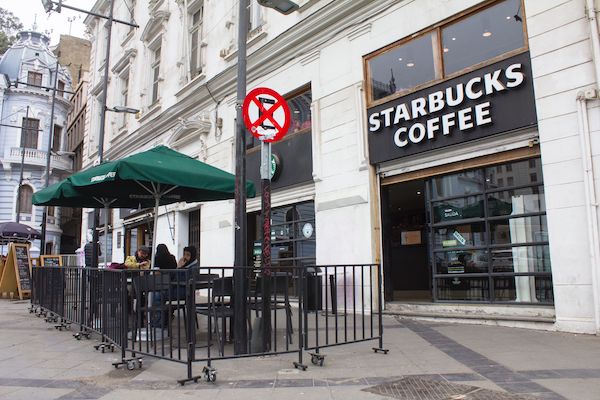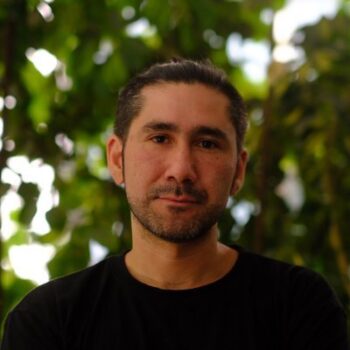When Starbucks workers in Chile formed a union in 2009, it took the company by surprise. A transnational corporation that had managed to prevent any of its workers from unionizing since 1971 watched as a group of young workers in a small Latin American country won a union. What is more, Chile wasn’t just any country but a symbol of US dominance in the region: the US had helped to organize the 1973 coup and subsequent implementation of the neoliberal model.
But how did a group of young people with no prior union experience manage to form what is now the largest fast-food union in Chile — and one of the few unions in the world with a collective bargaining agreement with Starbucks?
This article reflects on the process of unionization at Starbucks in Chile — a unionization drive that happened in the context of a vibrant student movement. In the 2000s, Chilean youth became a relevant political force in the country. As these student activists entered the workforce, they brought the experiences they accumulated over almost a decade of struggle.
This new generation of student and labor activists has started replacing older generations of labor leaders, particularly in retail and fast food. Several organizations of national importance are being led by workers under 40 years old; in the youngest organizations, there are a hundred leaders under the age of 20, including women or LGBTQ+ people. These new leaders sometimes clash with traditional unionism — where sexism, homophobia, and xenophobia are prevalent.
These new union leaders have fewer qualms about getting into political debates and taking political positions, and they believe it is necessary to aggressively confront management. This is reflected in the practices of the Starbucks union itself, where the leadership actively participates in the public debate and even follows union activities in other countries. As a result of the politicization of young workers, a new generation is re-building the unions that the dictatorship wanted to crush.
I am the current president of the Starbucks union in Chile. Before I became a union leader, I was a student activist. I entered the university in 2006 and quickly got involved in student organizing; by 2011 — one year after I started working at Starbucks — I had assumed the role of spokesperson for the students at my university. My union activism and my student activism have gone hand in hand.
The union has systematically increased membership across all of the Starbucks in Chile over the past four years. Management gives us a list of all of the employees at each location and we get 15 minutes to talk to each employee during the workday. We do this over and over, in all regions of the country. That’s how we got to have representation in the 144 stores that currently operate in Chile.
Now you have a sense of our strategy, but it is equally important to understand Starbucks’s profile as an employer. Starbucks is notorious for hiring young workers who often have no prior work experience, offering them a modern, flexible workplace with a “progressive” and “diversity-minded” organizational culture that can seem ideal while pursuing higher education. They count on the appeal of their workplace to young people as a way to maintain control of a workforce that is largely inexperienced.
Perhaps this corporate strategy is effective in other places but what Starbucks failed to observe in Chile was that their target employee demographic was university students who had undergone a process of politicization. By 2009, many Starbucks workers had already been leaders of the thousands of school takeovers that occurred nationwide. Many more had been activists in their schools or had organized in the streets to confront government repression. The experience of leading the student movement gave these workers the political analysis to link their conditions as students and their conditions as workers. Importantly, many Starbucks employees occupy both positions. Organizing a union seemed like a natural next step in their journey to take control over their work and educational lives and also shape the societal debates that were occuring over labor law reform and educational reform. The result was an active, well-organized, and influential union. (It’s important to note that earlier generations did not have the same opportunities for developing political and organizational capacity because of the repression of the dictatorship; the subsequent policies of cooptation and passivity introduced by the governing political parties of the “transition to democracy”; and a weak and ineffective central labor federation, which has traditionally be led by the Socialist, Communist, and Christian Democratic parties.)
One of the most significant moments of our union’s history came in 2011 when we went on strike for four weeks over an impasse in contract negotiations. The strike happened in the context of a ten-month student strike, the largest the country had ever experienced. There was a lot of synergy between the student strike and the union strike. Students came to our picket lines and the union joined student marches. The militancy of the union strike was fueled by the energy of the students in the streets. In some cases, Starbucks workers were also university students and so they were participating in simultaneous strikes. The student movement also helped normalize the idea of a strike, which many young Starbucks workers didn’t have experience with.
While our union has gone on strike three times and bargained five contracts, the 2011 strike was by far the largest and most militant. In 2011, we had only organized 56% of Starbucks stores in the country, but all 200 workers went out. In addition to the strike, three union leaders went on a hunger strike outside of Starbucks corporate offices. This created greater visibility for our movement and forced the public to reckon with Starbucks’s anti-union practices.
Based on Chilean labor law, after 30 days of striking, we had to make a choice. We could either accept management’s last and best offer or postpone bargaining for 18 months. We chose to postpone bargaining, which forced us back to work, having lost significant wages. Needless to say, this was deeply demoralizing to workers who had participated in the strike. Between 2011-2019 our union organizing and internal capacity building suffered a lot. People felt hopeless. The way we dealt with some of the disorganization and demobilization was to pursue a legal strategy.
Ours was one of the first unions to begin litigating the company’s anti-union practices, which included holding captive audience meetings, using scare tactics to pressure workers into leaving the union, and forcing people out of employment altogether. Starbucks was careful not to leave a written record that we could use against them. However, despite a successful legal strategy in which we won multiple lawsuits over these anti-union practices, Starbucks nonetheless continued to violate the law. In short, the legal system proved totally ineffective in protecting the collective rights of workers, often favoring national and transnational companies over them.
The Social Uprising and Constitutional Process
The year 2019 demolished the myth that Chile is an “oasis” of stability in a region that seems to undergo constant cycles of social unrest.
The Chilean social uprising that occurred in October 2019 marked a turning point in the regime inherited from the dictatorship and its defenders in the right and center-left bourgeois parties. It was youth under 30 — who did not see their future due to global warming, who were born into capitalism permanently in crisis, and who had little hope of a better life — who took to the streets to confront the powers of the establishment. Like the union moment, the protests were led by all those young people who developed their politics in assemblies, takeovers, and marches at their schools and universities. Young people came out en masse to challenge the social pact created by the transition to democracy and to tear it all down.
Marginalized sectors were also present in this uprising: young people excluded from society, those who live on the streets, and those who passed through the SENAME (Chile’s juvenile detention system) all found in the demonstrations a sense of belonging and the possibility of achieving a historic milestone. Together, they formed a single line of combat that included both working-class and educated youth.
The agreement between the government and the opposition to initiate a constitutional convention process generated high expectations in those who participated in the protests and who welcomed the possibility of improving living conditions. However, the proposed constitution was too moderate. This was a huge disappointment to many social movement activists and to key members of our leadership in the Starbucks union.
The new constitution kept the economic model intact while granting social rights that would have been difficult to make a reality in the short and medium term. As such, our union’s Delegate Assembly made a political decision not to campaign for or against the proposed constitution. We believe that workers’ organizations should not be subordinated to the projects of the business sector and its politicians, whether they are progressive or not. We must have political independence that puts class interests and the project of strengthening workers’ organizations above all else. At the same time, we understood the importance of the historical moment, and we condemned the fear and misinformation that right-wing forces spread in working-class neighborhoods.
At the end of the day, the results of the September 4th plebiscite were not surprising. Polls consistently predicted that the rejection side would win. It was the most probable scenario. But the key to what happened needs to be understood as the culmination of the process that was put into place with the peace agreement on November 15, 2020. The peace agreement sought to remove the working class from the streets. It was the last attempt of the institutionalized neoliberal order to reestablish control over the protests. And that effort was supported by the political forces that are part of the current government.
President Boric, the convention process, and the political elite are responsible for the results. The “progressive” discourses of the convention shied away from debates around urgent economic needs: in their place, we were left with social rights that were written but not guaranteed. The hundreds of hours of debate on these important social issues simply did not make sense to people who are unemployed, suffering the effects of inflation, or have had to give up basic necessities to survive. The convention tried to rewrite history, but it didn’t change the material conditions necessary for that to be a reality.

